![]()
![]()
![]()
Use LEFT and RIGHT arrow keys to navigate between flashcards;
Use UP and DOWN arrow keys to flip the card;
H to show hint;
A reads text to speech;
40 Cards in this Set
- Front
- Back
|
Where is the right lobe of the pancreas found across species?
|
Located within the mesoduodenum
|
|
|
At what level is the pancreas located in the equine?
|
Sits transversely on the dorsal wall of the abdomen at the 17th thoracic vertebra
|
|
|
Where is the left lobe of the pancreas found in the equine? In the ruminant?
|
Located within the deep layer of the greater omentum in the equine.
In the ruminant: Located within the dorsal attachment of the greater omentum at the root of the mesentery |
|
|
What is the body of the pancreas?
|
Joins the two lobes
|
|
|
Where do the pancreatic and accessory panceatic duct drain in the horse?
|
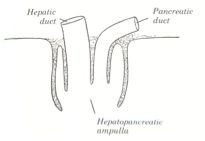
Pancreatic duct drains at the major duodenal papilla (hepatopancreatic ampulla) in the duodenum along with the common hepatic duct
Accessory pancreatic duct drains at the minor duodenal papilla |
|
|
What are the main pancreatic and accessory pancreatic ducts of ox and small ruminants? What does the pancreatic duct drain with in the ruminant?
|
Pancreatic duct
Drains at the major duodenal papilla in the duodenum along with the common bile duct Main duct in small ruminants Occasionally present in the ox Accessory pancreatic duct Drains at the minor duodenal papilla Main duct in the ox Not present in small ruminants |
|
|
What are the twists and turns of the equine small intestine?
|

Cranial part
Cranial duodenal flexure Descending duodenum (2) Caudal duodenal flexure -Courses caudal to the cranial mesenteric artery Ascending duodenum (3) Duodenojejunal flexure |
|
|
What is the mesoduodenum? What does it course between in the equine?
|
Between the cranial part of the duodenum and the liver
Between the descending duodenum and the right dorsal colon Between the ascending duodenum and base of the cecum and the right kidney |
|
|
What is the duodenocolic fold of the equine?
|
Between the ascending duodenum and descending colon
|
|
|
What is the major duodenal papilla a site of drainage for?
|
Site of drainage of the common hepatic duct and pancreatic duct
|
|
|
What is the minor duodenal papilla a site of drainage for?
|
Site of drainage of the accessory pancreatic duct
|
|
|
What else is mesojejunum known as? What does it course between? What is in the root of the mesentery? What level is the root of the mesentery in the equine?
|
mesentery
Courses between the dorsal abdominal wall (around the cranial mesenteric artery at L1 vertebra) and the jejunum |
|
|
Where does ingesta flow after the ileum in the equine? Via what opening?
|
Ingesta flows from the ileum to the cecum via the ileocecal orifice at the ileal papilla
No ileocolic orifice |
|
|
What is the implication of there being no ileocolic orifice in the horse?
|
ingesta must go from ileum to cecum to colon
|
|
|
What courses between the antimesenteric surface of the ileum and the dorsal cecal band of the equine?
|
Ileocecal fold
|
|
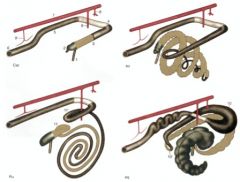
Despite the species differences, name the parts of these large intestines (1-9').
|

1. Ileum
2. Cecum 3. Ascending colon 4. Transverse colon 5. Descending colon 6. Rectum 7. Aorta 8. Celiac artery 9. Cranial mesenteric artery 9’. Caudal mesenteric artery |
|
|
What are synonyms to bands and haustra that we need to know?
|
Teniae (bands)
Smooth muscle and elastic fibers Oriented longitudinally Haustra (sacculations) |
|
|
What are the numbers of bands on the large intestine?
|
Cecum – 4
Right ventral colon – 4 Left ventral colon – 4 Left dorsal colon – 1 Right dorsal colon – 3 Transverse colon – 2 Descending colon – 2 444-1322 |
|
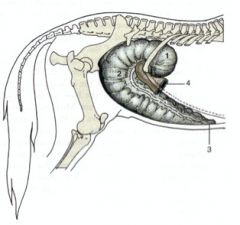
Name the regions of the cecum. Which is most secured?
|

Base (1)
-Located in the right paralumbar fossa -most secured Body (2) Apex (3) -Located on the floor of the abdomen near the xiphoid cartilage |
|
|
What are the names of the four bands of the cecum? What do they course between (if anything) and what vessels are associated with them (if any)?
|

Dorsal cecal band
Ileocecal fold Courses between the ileum and cecum Ventral cecal band Medial cecal band Medial cecal artery and vein Lateral cecal band Cecocolic fold Courses between the cecum and the right ventral colon Lateral cecal artery and vein |
|

This is a dorsal view of the equine intestines. The key is included, but can you name them?
|
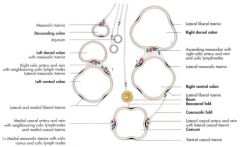
Here are transverse sections of the equine colon. Can you name the areas without the labels?
|
|
|
Follow ingesta from the ascending colon to descending colon with bands listed.
|

Ascending colon
Right ventral colon (4) Sternal flexure Left ventral colon (4) Pelvic flexure -Midway point of ascending colon Left dorsal colon (1) Diaphragmatic flexure Right dorsal colon (3) Transverse colon (2) Courses right to left cranial to the cranial mesenteric artery Descending colon (2) |
|
|
How many bands do the cecum, right ventral colon and left ventral colon? What is the pneumonic to remember that?
|
4.
4 on the floor. |
|
|
Jejunum v small colon.
Tenaie? Haustra? LN location? Which is fatter? Vasa recti? |
Jejunum
No teniae No haustra Lymph nodes located at root of mesentery Less fat in mesentery Vasa recti (straight vessels) longer and farther apart Small colon Teniae Haustra Lymph nodes located along mesocolic attachment More fat in mesentery Vasa recti shorter and closer together |
|
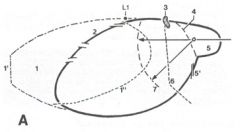
In a rectal exam, what are the structures labeled here that you can palpate?
|

1. Thoracic cavity
2. Diaphragm 3. Tuber coxae 4. Terminal line 5. Pelvic cavity 6. Thigh and stifle 7. Approximate range in rectal palpation |
|
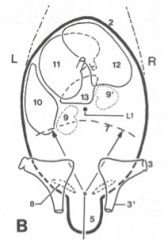
In a rectal exam, what equine structures here can you palpate?
|

Everything behind the dashed line
1. Thoracic cavity 2. Diaphragm 3. Tuber coxae 4. Terminal line 5. Pelvic cavity 6. Thigh and stifle 7. Approximate range in rectal palpation 8. Deep inguinal ring 9. Left kidney; 9’. Right kidney 10. Spleen 11. Stomach 12. Liver 13. Pancreas |
|
|
What are the fixed/non-fixed abdominal organs palpable on the left side of the horse?
|
Left side
Fixed Spleen Renosplenic ligament Left kidney Vaginal ring Non-fixed Left ventral colon Pelvic flexure Left dorsal colon Descending colon Jejunum Ileum |
|
|
What are the fixed/non-fixed abdominal organs rectally palpable on the right side of the horse?
|
Right side
Fixed Caudal duodenal flexure Ileocecal junction Base of cecum Vaginal ring Non-fixed Jejunum Ileum Descending colon |
|
|
What are the common sites for blockage in the equine digestive tract and why?
|
Any place that goes to a small diameter or a tight turn can be susceptible.
Caudal duodenal flexure Cecum Ileocecal orifice Sternal flexure Pelvic flexure - narrowing and sharp bend Transverse colon - narrowing Rectum |
|
|
What are the twists and turns of the bovine duodenum?
|
Duodenum
Cranial part Cranial duodenal flexure Descending duodenum Caudal duodenal flexure Courses caudal to the cranial mesenteric artery Ascending duodenum Duodenojejunal flexure |
|
|
In what area does the majority of the jejunum sit in in the bovine?
|
Numerous coils located mostly in the supraomental recess on the right side of the rumen
|
|
|
Where does the ingesta flow to from the ileum in the bovine?
|
Ingesta flows from the ileum to the junction of the cecum and colon via the ileal orifice
|
|
|
Describe the course of ingesta flow in the bovine large intestine?
|
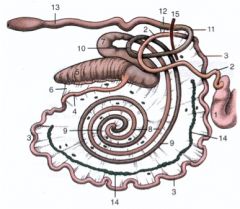
Cecum (5)
Ascending colon: -Proximal loop (7) -Spiral colon --Centripetal coils (8) --Central flexure --Centrifugal coils (9) -Distal loop (10) Transverse colon (11 Descending colon (12) with sigmoid flexure Rectum (13) |
|
|
What is the analogous structure to the pelvic flexure in the bovine?
|
The central flexure.
|
|
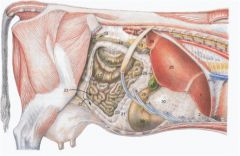
What are 16 and 17 here?
|

16. Proximal loop of ascending colon
17. Cecum |
|

What is the difference in the large and small ruminant jejunal lymph nodes? What's the clinical signifigance?
|

Large ruminant – jejunal (mesenteric) lymph nodes located in the mesentery near the jejunum
Small ruminant – last centrifugal coil located in the mesentery near the jejunum Clinical signifigance - if you try and use the same landmarks for lymph node biopsies, you'll get intestine in one of the animals. |
|
|
What are the rectally palpable fixed and non-fixed abdominal organs in the ox on the left side?
|
Left side
Fixed Rumen Left kidney Vaginal ring Non-fixed Body and apex of cecum Jejunum Ileum |
|
|
What are the rectally palpable fixed and non-fixed abdominal organs in the ox on the right side?
|
Right side
Fixed Caudal duodenal flexure Base of cecum Spiral colon Vaginal ring Non-fixed Jejunum Ileum |
|
|
Do camelids have spiral colons?
|
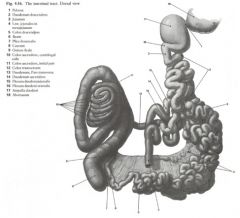
Yes.
Also, these lymph nodes are enlarged - they shouldn't be that big. |
|
|
Do pigs have a spiral colon?
|
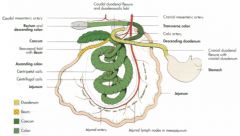
Yes
|

